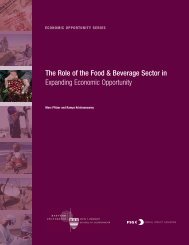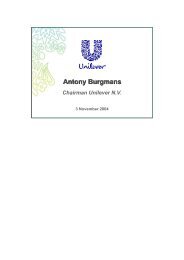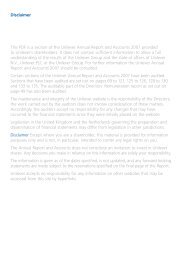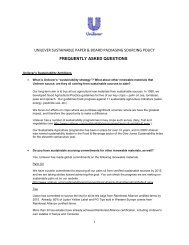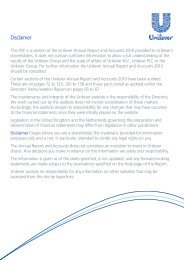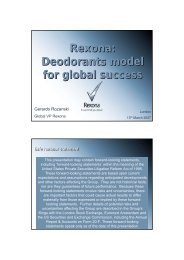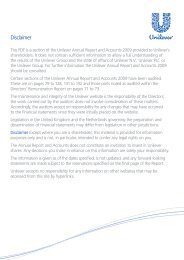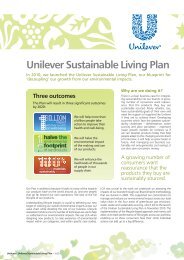Unilever Tea Kenya Limited - Rainforest Alliance
Unilever Tea Kenya Limited - Rainforest Alliance
Unilever Tea Kenya Limited - Rainforest Alliance
You also want an ePaper? Increase the reach of your titles
YUMPU automatically turns print PDFs into web optimized ePapers that Google loves.
6<br />
Introduction<br />
Birds are one of the best-studied classes of organism and<br />
almost certainly the best-known group of vertebrates.<br />
There have been numerous studies on forest birds of<br />
eastern Africa, and most species are readily identifiable<br />
using field guides and standard reference works (e.g.,<br />
Zimmerman et al. 1996). Ecologically, birds also benefit<br />
humans by providing important ecosystem services, such<br />
as: provisioning services via game meat for food, feathers<br />
for garments and guano for fertilizer; regulating services<br />
by scavenging carcasses and waste, by controlling<br />
populations of invertebrate and vertebrate pests, by<br />
pollinating and dispersing the seeds of plants; cultural<br />
services, as exemplified by the prominent roles of birds in<br />
art and religion and by the billions of dollars spent on birdwatching;<br />
and supporting services by cycling nutrients<br />
and by contributing to soil formation (Sekercioglu 2006).<br />
The African Crowned Eagle, Stephanoaetus coronatus,<br />
is an example of a top predator in some forests, and may<br />
take prey as large as Colobus Monkeys.<br />
Birds are often considered as a useful indicator<br />
group, either for monitoring environmental change or<br />
for assessing biodiversity importance (Brooks et al.<br />
2001). Birds as a group have many characteristics that<br />
make them good indicators: they are well-studied,<br />
taxonomically stable, easily surveyed, widely-distributed<br />
across almost all habitats, and include both generalised<br />
and specialised species. There are enough bird species<br />
(about 1,100 species in <strong>Kenya</strong>, more than 1,300 in East<br />
Africa, and more than 2,170 in Africa) to make meaningful<br />
comparisons between sites, but few enough that<br />
taxonomic and identification problems are rarely an issue<br />
(Davies 2002).<br />
Agriculture expansion into forestland triggers loss of<br />
natural habitat, faunal and floral species declines or<br />
changes in species composition. For birds, for instance,<br />
there could be a loss or interference of nesting and<br />
breeding grounds. These negative impacts on biodiversity<br />
often translate to a deterioration of the services these<br />
biodiversity provide, and that people are dependent<br />
upon. As a result, it is very important to regularly take<br />
stock of the existing biodiversity and hence establish<br />
changes overtime in order to assess the impact of these<br />
changes.<br />
UTK-Kericho: Avian assessment 2009<br />
<strong>Tea</strong> estates can contribute to biodiversity through striving<br />
to restore and retain the world’s indigenous forest cover.<br />
Indigenous trees play a critical role in our environment<br />
through water retention, stabilisation of soil profiles and<br />
as a contributor to biodiversity. <strong>Tea</strong> estates can take<br />
deliberate actions within their own boundaries to support<br />
both water catchment conservation and biodiversity. This<br />
is the basis and ultimate goal for <strong>Unilever</strong>’s Innovative<br />
Sustainable Agriculture Program. This approach to<br />
sustainable agriculture is based upon four key principles:<br />
Producing crops with high yield and nutritional quality to<br />
meet existing and future needs, whilst keeping resource<br />
inputs as low as possible; Ensuring that any adverse<br />
effects on soil fertility, water and air quality and biodiversity<br />
from agricultural activities are minimised and positive<br />
contribution will be made where possible; Optimising the<br />
use of renewable resources whilst minimising the use of<br />
non-renewable resources; Enabling local communities to<br />
protect and improve their wellbeing and environments.<br />
Sustainable Agriculture is productive, competitive<br />
and efficient while at the same time protecting<br />
and improving the natural environment and<br />
conditions of the local communities<br />
Excerpt of <strong>Unilever</strong>’s Sustainable Agriculture Mission Statement<br />
formally adopted in December 1998<br />
In addition to these four principles, ten indicators<br />
were selected to measure progress of the sustainable<br />
agriculture practices implemented (see Appendix IV).<br />
Of interest here is Indicator 5 which focuses entirely<br />
on biodiversity and its interaction with agriculture. It is<br />
clear that agriculture has shaped most ecosystems in<br />
the world, and biodiversity can be improved or reduced<br />
by agricultural practices. Besides, some biodiversity<br />
is highly beneficial for agriculture e.g., pollinators and<br />
pest control agents. Sustainable agriculture practices<br />
endeavour to improve biodiversity, both by ‘greening the<br />
middle’ of fields as well as ‘greening the edge’. Some<br />
parameters identified for assessing this indicator include:<br />
level of biodiversity on site, habitat for natural predator<br />
systems, cross boundary effects.





